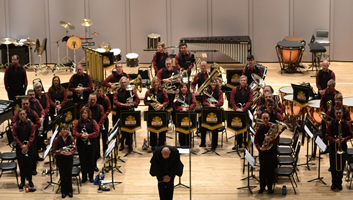Gustav Mahler’s Seventh Symphony is a magnificent edifice built symmetrically of five hefty movements. It starts in one key (B minor as the dominant of E minor) and finally ends exuberantly nearly an hour and a half later in the unrelated key of C, sounding like the triumphant winner of Richard Wagner’s master singer’s competition. Like a wizard, Mahler leads us through a maze of complex harmonies, tonal ambiguities and key shifts which would dazzle even a mythological shape-shifter. Less tragic than his Sixth Symphony, and more complex than the lyrical Fifth Symphony, the Seventh Symphony is another stride that eventually culminates in the monumental and heroic Das Lied von der Erde.
Like a French Overture of the Baroque era, the symphony starts with a double-dotted rhythm in the strings and lower woodwinds playing a singular bitter-sweet chord, a B minor chord with an added major sixth, a chord which recurs at several instances. Almost immediately the tenor horn intrudes loudly with a jagged theme (based on the B6 chord) which characterizes almost all its entrances in the movement. The funereal trudge of the double-dotted rhythm gradually picks up, starting all over and eventually morphing into a resolute march in E minor. The violins introduce a second subject, fraught with expressive hitches, slides and arpeggios, quite the contrast with anything that precedes it. The harps usher in a sublime moment by playing a divine glissando in unison.
Contrast and juxtaposition of moods and character inhabit every movement of this unusual symphony. In addition to the three traditional movements that anchor the work – the sonata-form first movement, a Scherzo as the third movement, and a cheerful Rondo as the final movement – sandwiched between these movements are two Nachtmusik (Night Music). The first Nachtmusik is a 15-minute rondo which alternates shiftily between major and minor, and which features some fine horn playing. The two Night Music movements are separated by perhaps the most conventional of the five movements, a Scherzo (with a Trio), although even its quick three-beat tempo seems to mock the vaunted Viennese waltz. Mahler’s instructions in the score read: “Shadowy; flowing but not fast; in the beginning measures, still a bit hesitant.” The second Nachtmusik is the quietest and most intimate of the five movements, featuring some lovely string solos and allowing us to hear an occasional guitar chord and some plaintive plucking of the mandolin as the movement wavers and gently drifts into silence.
The last movement, Rondo-Finale, is marked Allegro Ordinario, (a most unusual qualifier!) and starts with bravura with a two-measure timpani solo, a “flourish of drums and hautboys.” Woodwinds are asked to raise their bells in the air, making them look (and sound) somewhat like trumpets. We hear musical quotations from Wagner and Mozart as Mahler tries to make this movement joyful – but true to his nature, the plaintive enters and calls to the macabre, only to return blatantly to the cheerful, the raucous and then the dreamy. The audience cheered and sprang to its feet as the final chord punctured the air.
The North Carolina Symphony, under the direction of its music director, Grant Llewellyn, was magnificent! This is clearly a fine orchestra with excellent soloists in all the principal positions. One marveled at the subtle phrasing of the concertmaster, the rich tone of the principal viola, the perfectly matched expression and vibratos of the two principal cellos, the clean attacks of all the trumpets (especially in the upper register), and the inexhaustible energy (if occasionally slightly sharp) and power of the principal horn. Innumerable fine solos emanated from the unusually large woodwind section which in the loudest passages somewhat overpowered even the large 51-person string section. Compared to most of Mahler’s symphonies, the brass section is conservative, adding only a “tenor-horn” for the first movement – but what an addition! The percussion instruments include the usual drums, cymbals, gongs and triangles, but also a bundle of sticks (rute) struck against the outside rim of the bass drum, as well as dozens of bells of all callings, from cow to chimes. Two harps, a guitar and a mandolin complete the orchestration!
Having led an extraordinary performance, Maestro Llewellyn was quick to share the applause with his musicians. He first asked retiring second violinist Paul Gorski to stand, followed by various soloists, and finally the entire orchestra, by sections.
Meymandi Hall, the south wing of the impressive Duke Energy Center for the Performing Arts, is the permanent home of the NC Symphony, and it has excellent acoustics. The orchestra sounded near, yet well balanced, with no one section favored. As most of the 7th Symphony of Mahler is fairly loud, I was unable to gauge either the hall or the orchestra’s ability to play in the very soft range of dynamics, usually the most difficult dynamic to balance the sections. But the forte and fortissimi were masterful!
This program repeats Saturday night at 8 pm in the same location. See our sidebar for details.












